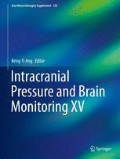Abstract
This paper describes the use of minute-by-minute monitoring data to determine continuous optimal cerebral perfusion pressure (CPP) recommendations based on the autoregulatory status of pediatric patients with traumatic brain injury. Data from 79 children were retrospectively studied. Optimal CPP recommendations were obtained for the majority of the first 72 h of monitoring time. Actual CPP close to recommended CPP values was significantly associated with better outcome and was a significant independent predictor of better outcome when considering IMPACT model covariates in multivariate logistic regression.
Access this chapter
Tax calculation will be finalised at checkout
Purchases are for personal use only
References
Rosner M, Daughton S (1990) Cerebral perfusion management in head injury. J Trauma 30:933–940
Guidelines for the management of severe traumatic brain injury – 3rd edition (2007) J Neurotrauma 24(Suppl 1): S1–S106
Guidelines for the acute medical management of severe traumatic brain injury in infants, children and adolescents (2003) Pediatr Crit Care Med 4(3 Suppl):S72–S75
Chambers IR, Jones PA, Lo TY, Forsyth RJ, Fulton B, Andrews PJ, Mendelow AD, Minns RA (2006) Critical thresholds of intracranial pressure and cerebral perfusion pressure related to age in paediatric head injury. J Neurol Neurosurg Psychiatry 77(2):234–240
Sviri GE, Aaslid R, Douville CM, Moore A, Newell DE (2009) Time course for autoregulation recovery following severe traumatic brain injury. J Neurosurg 111:695–700
Figaji AA, Zwane E, Fieggen AG, Argent AC, Le Roux PD, Siesjo P, Peter JC (2009) Pressure autoregulation, intracranial pressure, and brain tissue oxygenation in children with severe traumatic brain injury. J Neurosurg Pediatr 4(5):420–428
Czosnyka M, Smielewski P, Kirkpatrick P, Laing RJ, Menon D, Pickard JD (1997) Continuous assessment of the cerebral vasomotor reactivity in head injury. Neurosurgery 41:11–19
Brady KM, Shaffner DH, Lee JK, Easley RB, Smielewski P, Czosnyka M, Jallo GI, Guerguerian AM (2009) Continuous monitoring of cerebrovascular pressure reactivity after traumatic brain injury in children. Pediatrics 124(6):e1205–e1212
Zweifel C, Lavinio A, Steiner L, Radolovich D, Smielewski P, Timofeev I, Hiler M, Balestreri M, Kirkpatrick PJ, Pickard JD, Hutchinson P, Czosnyka M (2008) Continuous monitoring of cerebrovascular pressure reactivity in patients with head injury. Neurosurg Focus 25:E2
Steiner LA, Czosnyka M, Piechnik K, Smielewski P, Chatfield D, Menon DK, Pickard JD (2002) Continous monitoring of cerebrovascular pressure reactivity allows determination of optimal cerebral perfusion pressure in patients with traumatic brain injury. Crit Care Med 30:733–738
Aries MJ, Czosnyka M, Budohoski KP, Steiner LA, Lavinio A, Kolias AG, Hutchinson PJ, Brady KM, Menon DK, Pickard JD, Smielewski P (2012) Continuous determination of optimal cerebral perfusion pressure in traumatic brain injury. Crit Care Med 40:2456–2463
Depreitere B, Güiza F, Van den Berghe G, Schuhmann M, Maier G, Piper I, Meyfroidt G (2014) Pressure autoregulation monitoring and cerebral perfusion pressure target recommendation in severe traumatic brain injury patients based on minute-by-minute monitoring data. J Neurosurgery 120(6):1451–1457
Murray GD, Butcher I, McHugh GS et al (2007) Multivariable prognostic analysis in traumatic brain injury: results from the IMPACT study. J Neurotrauma 24:329–337
Piper I, Citerio G, Chambers I, Contant C, Enblad P, Fiddes H, Howells T, Kiening K, Nilsson P, Yau YH (2003) The Brain-IT group: concept and core dataset definition. Acta Neurochir (Wien) 145:615–628. http://www.brainit.org
Güiza F, Depreitere B, Piper I, Van den Berghe G, Meyfroidt G (2013) Novel methods to predict increased intracranial pressure during intensive care and long-term neurologic outcome after traumatic brain injury: development and validation in a multicenter dataset. Crit Care Med 41:554–564
Robertson CS, Valadka AB, Hannay HJ, Contant CF, Gopinath SP, Cormio M, Uzura M, Grossman RG (1999) Prevention of secondary ischemic insults after severe head injury. Crit Care Med 27:2086–2095
Eker C, Asgeirsson B, Grände PO, Schalén W, Nordström CH (1998) Improved outcome after severe head injury with a new therapy based on principles for brain volume regulation and preserved microcirculation. Crit Care Med 26:1881–1886
Howells T, Elf K, Jones PA, Ronne-Engström E, Piper I, Nilsson P, Andrews P, Enblad P (2005) Pressure reactivity as a guide in the treatment of cerebral perfusion pressure in patients with brain trauma. J Neurosurg 102:311–317
Santos E, Diedler J, Sykora M, Orakcioglu B, Kentar M, Czosnyka M, Unterberg A, Sakowitz OW (2011) Low-frequency sampling for PRx calculation does not reduce prognostication and produces similar CPPopt in intracerebral haemorrhage patients. Acta Neurochir (Wien) 153:2189–2195
Acknowledgments
This study was supported by the Foundation for Scientific Research Flanders (FWO) (Research project G. 0904.11). Geert Meyfroidt receives funding from FWO as senior clinical investigator (1846113 N). Greet Van den Berghe receives long-term structural research financing via the Methusalem program funded by the Flemish Government (METH/08/07). We would like to acknowledge I.R. Chambers, P.A. Jones, T.Y.M. Lo, R.J. Forsyth, B. Fulton, P.J.D. Andrews, A.D. Mendelow, and R.A. Minns who designed the original study resulting in the pediatric database used here.
Conflict of Interest Statement
The authors declare that they have no conflict of interest.
Author information
Authors and Affiliations
Corresponding author
Editor information
Editors and Affiliations
Rights and permissions
Copyright information
© 2016 Springer International Publishing Switzerland
About this chapter
Cite this chapter
Güiza, F., Meyfroidt, G., Lo, TY.M., Jones, P.A., Van den Berghe, G., Depreitere, B. (2016). Continuous Optimal CPP Based on Minute-by-Minute Monitoring Data: A Study of a Pediatric Population. In: Ang, BT. (eds) Intracranial Pressure and Brain Monitoring XV. Acta Neurochirurgica Supplement, vol 122. Springer, Cham. https://doi.org/10.1007/978-3-319-22533-3_38
Download citation
DOI: https://doi.org/10.1007/978-3-319-22533-3_38
Publisher Name: Springer, Cham
Print ISBN: 978-3-319-22532-6
Online ISBN: 978-3-319-22533-3
eBook Packages: MedicineMedicine (R0)

